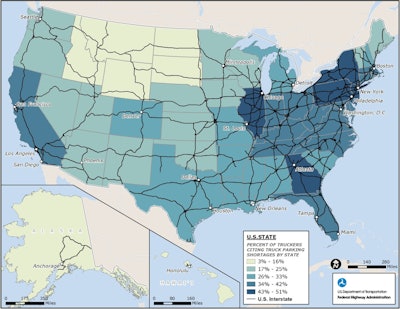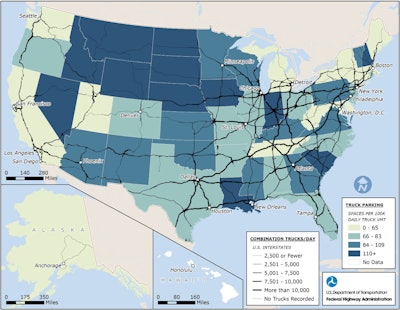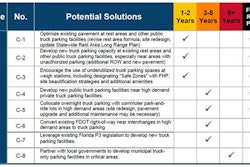
New comprehensive truck parking survey and inventory results unveiled Dec. 1 show that gains in truck parking space availability over five years have been made in many regions. Yet nationally, growth in truck traffic and parking demand continues to outpace new capacity development, resulting in “increased congestion and competition for parking, particularly in major metropolitan areas,” said Federal Highway Administration Deputy Administrator Mala Parker.
Jeff Purdy, with FHWA’s Office of Freight Management and Operations, bluntly summarized the situation: “Truck parking shortages are still a major problem in every state and region of the country.” Until society recognizes the toll this takes on those behind the wheel, and their livelihoods, the problem is likely to persist.
Yet there have been positive results from the long repercussions of Jason’s Law’s post-2012 implementation all around the nation. New data revealed a 6 percent increase in the number of truck parking spaces publicly administered (largely rest areas), said Purdy. An even bigger increase was seen from private truck stop and other operators — 11 percent — yet “really it hasn’t kept pace with truck vehicle miles traveled” over the same time period.
Purdy and Parker spoke during the National Coalition on Truck Parking’s annual meeting to present key findings of this first major update to the initial parking inventory and survey it conducted in 2014, following the 2012 codification of Jason’s Law truck parking safety and security legislation. That legislation effectively made addressing truck parking shortages “a national priority” for infrastructure planning and funding, said Parker.
Other FHWA officials and stakeholders, including the American Trucking Associations and the Owner-Operator Independent Drivers Association, emphasized continuing challenges.
The original Jason’s Law survey showed the most problematic corridors – I-95 in the Mid-Atlantic into New York, the area around Chicago, sections of I-5 in California out West — but this latest effort shows those problem areas’ “range is expanded,” Purdy said. The I-95 corridor has great parking difficulty from Florida to New England, Chicago’s area is “even more of a problem and more expansive,” and the “entire Pacific corridor,” not just California, is a hot spot for shortages.
Percent of truckers citing states with shortages (2019 Jason’s Law survey data)
 Drivers responded in bigger numbers to the 2019 survey effort than the prior effort in 2014, highlighting their growing attention to the issue. The most-cited states for shortages were, in order, New York, New Jersey, Pennsylvania, Illinois and Georgia.
Drivers responded in bigger numbers to the 2019 survey effort than the prior effort in 2014, highlighting their growing attention to the issue. The most-cited states for shortages were, in order, New York, New Jersey, Pennsylvania, Illinois and Georgia.Number of truck parking spaces by state and per 100,000 truck vehicle miles traveled (2019 Jason’s Law survey data)
 States shaded the lightest color on this map show the fewest number of available spaces based on the amount of heavy truck traffic estimated in the state. This look at parking coverage based on truck volume also illustrates the value of truckers’ input. Among states with few spots relative to traffic is one along a corridor earmarked as difficult in driver surveys, Purdy said — I-40 through the Southern states, where Tennessee shows fewer than 65 spots per 100,000 vehicle miles traveled. Purdy detailed other findings now that survey data is in, compared to the original Jason’s Law survey. A comprehensive report will be released next year, yet data is available for planners, researchers and the public via this link, scroll to “Jason’s Law 2019 Truck Parking Survey and Assessment.”
States shaded the lightest color on this map show the fewest number of available spaces based on the amount of heavy truck traffic estimated in the state. This look at parking coverage based on truck volume also illustrates the value of truckers’ input. Among states with few spots relative to traffic is one along a corridor earmarked as difficult in driver surveys, Purdy said — I-40 through the Southern states, where Tennessee shows fewer than 65 spots per 100,000 vehicle miles traveled. Purdy detailed other findings now that survey data is in, compared to the original Jason’s Law survey. A comprehensive report will be released next year, yet data is available for planners, researchers and the public via this link, scroll to “Jason’s Law 2019 Truck Parking Survey and Assessment.”Addressing the many challenges of the parking shortage will continue to require a collaborative effort between highway users, private operators and federal, state and local governments. Funding is a challenge, and pursuit of greater public-private partnership efforts to build public capacity and/or deliver better information on availability was mentioned by stakeholders. OOIDA and ATA representatives referred directly or indirectly to House bill H.R. 6104, introduced around the time the COVID pandemic began, as holding potential for increasing funding to boost public parking capacity.
The bill would “dedicate federal funding to truck parking,” said Bryce Mongeon, OOIDA director of legislative affairs. It would set aside money for adding capacity to the tune of “$755 million over five years,” administered to states in a competitive grant program. “The funding could be used for any capacity expansion,” including a rest area or other solution along a right of way. “One of the points we’ve been impressing on lawmakers [is that] no amount of parking is too small – any space is useful,” and public-private partnership funding possibilities are also part of the legislation.
The bill garnered 13 co-sponsors, close to evenly split from both political parties. “We’ve been pleased with bipartisan recognition that this is a safety issue first and foremost,” Mongeon said. “We believe we’re in a good position to gain more support on it heading into the new Congress,” with a goal of potentially adding the dedicated funding approach to the next long-term highway reauthorization.
It’s long been clear the parking capacity shortage is a high-priority item for Overdrive readers and other truckers. It’s the top concern in this year’s broad survey of top-priority issues for drivers conducted by the American Transportation Research Institute, though it fails to gain similar traction among carrier respondents to that survey.
Nearing the end of the National Coalition’s virtual meeting, FHWA Director Caitlin Hughes read an email message from Desiree Wood, trucker and head of the Real Women in Trucking organization. Wood has been long involved in spurring Jason’s Law going back to the time of Jason Rivenburg’s murder in South Carolina while parked at an abandoned fueling facility in lieu of a better option.
Hughes and Wood emphasized the bedrock importance of the issue. Wood noted she knew of “truck drivers pulled over on the side of the road right now listening to this meeting,” Hughes said. “This is critical to their livelihoods. They care deeply about the Jason’s Law program … and they hope to see that focus continue under the moniker of Jason’s Law,” she said, paraphrasing Wood.
Hughes went on to thank Rivenburg’s widow, Hope Rivenburg, also a key player in the legislation and its implementation.











